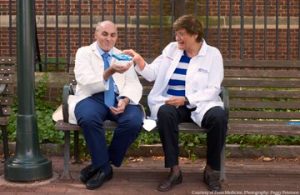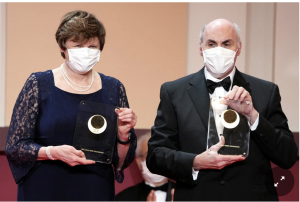Carolyn R. Bertozzi, Morten Meldal, and K. Barry Sharpless were awarded the Nobel Prize in Chemistry on Wednesday for their contributions to click chemistry and bio-orthogonal chemistry. The committee observed that Dr. Sharpless is the fifth scientist to receive two Nobel prizes, and Dr. Bertozzi is the eighth woman to receive the award.
Also Read| Carolyn R. Bertozzi, Morten Meldal and K. Barry Sharpless win 2022 Nobel Prize in Chemistry
What is click chemistry?
Founded by K. Barry Sharpless in 1998, click chemistry refers to a class of reactions that are quick, easy to use, simple to purify, versatile, regiospecific, and yield high product yields.
Sharpless, Hartmuth Kolb, and M.G. Finn of The Scripps Research Institute first fully described click chemistry in 2001.
“Click” chemistry is a family of biocompatible small molecule reactions that are frequently utilised in bioconjugation in chemical synthesis and enable the combining of preferred substrates with certain biomolecules. The term “click chemistry” refers to a method of producing items that mimics natural processes that also produce compounds by fusing small modular parts together.
Also Read| Who is Morten Meldal?
Click reactions link a biomolecule and a reporter molecule in numerous applications. Click chemistry is not just used in biological settings; it has also been applied in chemoproteomic, pharmaceutical, and different biomimetic contexts. They have been particularly effective in the identification, localization, and classification of biomolecules, though.
Click reactions take place in a single pot, are unaffected by water, produce few and inoffensive byproducts, and are “spring-loaded”—characterized by a high thermodynamic driving force that propels it quickly and irreversibly to a high yield of a single reaction product with high reaction specificity (in some cases, with both regio- and stereo-specificity). Because of these characteristics, click reactions are particularly well suited to the problem of isolating and targeting molecules in complex biological environments.
Products in such environments must be physiologically stable, and any byproducts must be non-toxic (for in vivo systems).
Researchers have created bioorthogonal processes that are precise and controllable, which has increased the likelihood of achieving specific targets in intricate cell lysates. Recently, click chemistry has been modified for application in living cells, for instance, utilising tiny molecule probes that use click reactions to locate and bind to their targets.
Also Read| Who is Carolyn R. Bertozzi?
Click reactions have already shown to be helpful in a new generation of pulldown experiments (in which specific targets can be isolated using, for example, reporter molecules that bind to a certain column), and fluorescence spectrometry, despite difficulties with cell permeability, bioorthogonality, background labelling, and reaction efficiency (in which the fluorophore is attached to a target of interest and the target quantified or located).
Also Read| Who is Ray Dalio?
Recently, novel methods for incorporating click reaction partners onto and into biomolecules have been developed, such as the incorporation of unnatural amino acids containing reactive groups into proteins and the modification of nucleotides. These techniques are a subset of chemical biology, in which click chemistry plays a critical role by intentionally and specifically coupling modular units to various ends.






